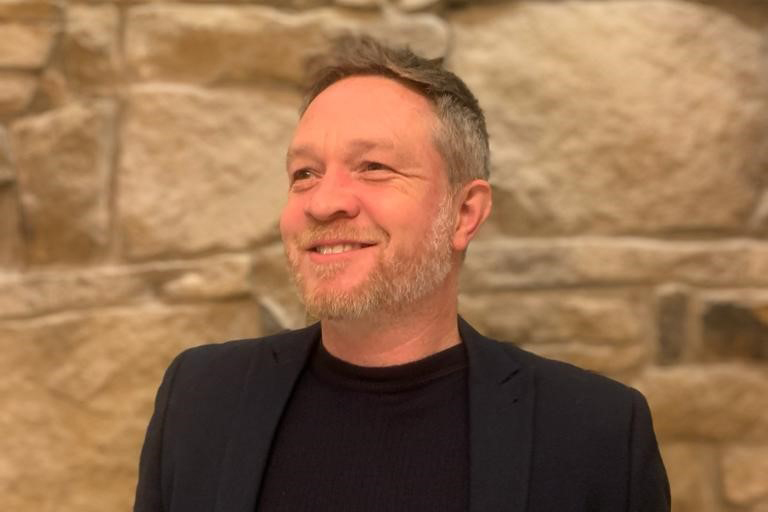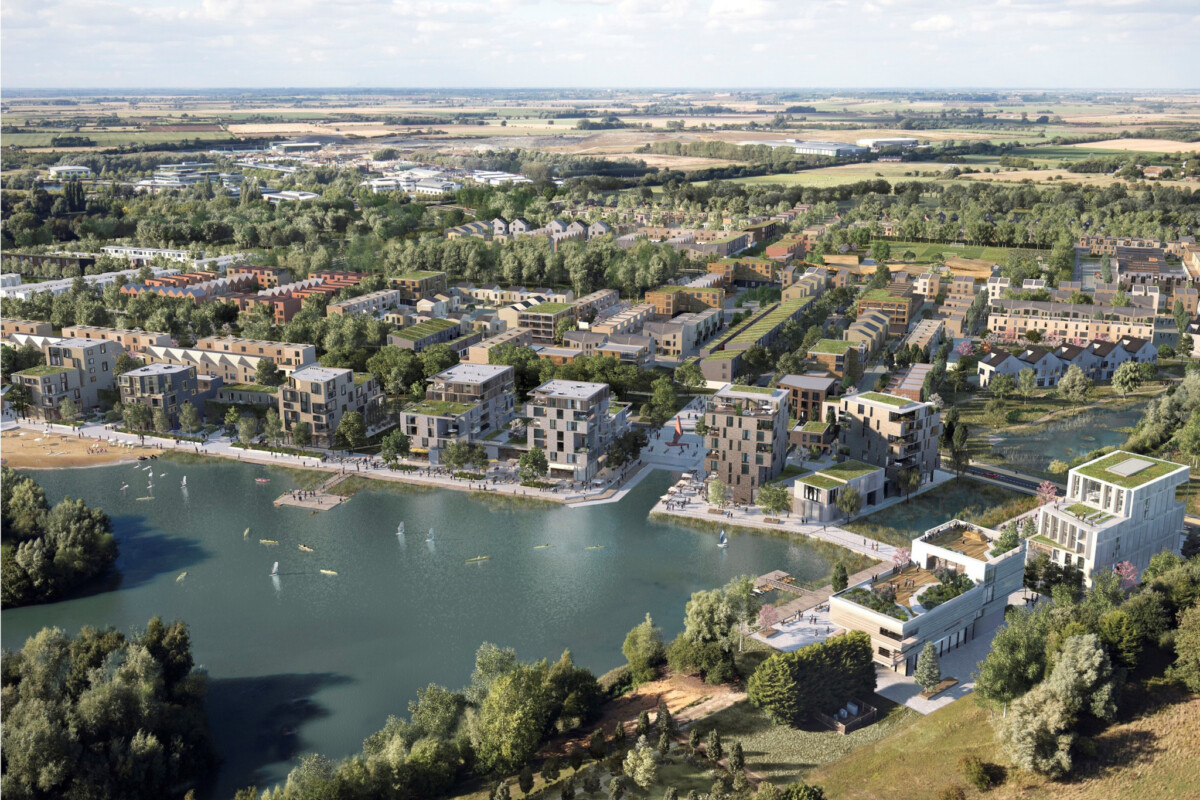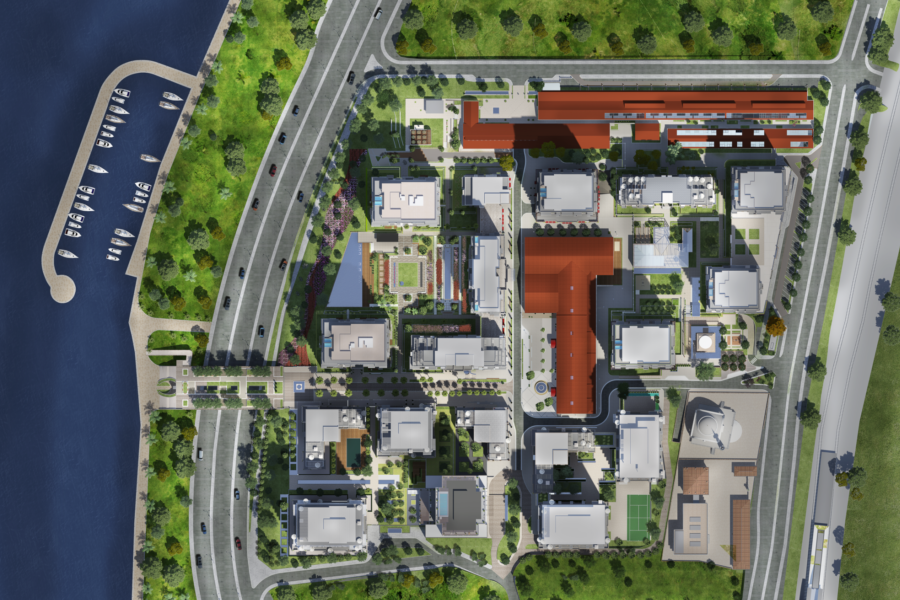
People profile: UK Associate Director Richard Daw on exciting developments in the Build-to-Rent and modular sectors
Richard Daw came back into the Chapman Taylor fold in 2021 with a particular focus on helping to grow our residential design capability in Manchester. In this profile, Richard talks through his sector expertise and explains how his upbringing has shaped his career choice and his approach to leadership.
How did you decide upon architecture as a career?
I’ve always known I wanted to be an architect. There’s a photo of me aged about four, with my dad, as he’s examining drawings. He worked for a small but significant, specialist building restoration company based in Essex called Bakers of Danbury. They worked on some very prestigious projects such as the restoration of St Albans and St Paul’s Cathedrals. Our house was always full of amazing hand-drawn pictures of stained-glass windows and stonework detailing, so I grew up with an appreciation of this intricately drawn information. My gran was an artist as well, which gave me a further interest in drawing and painting. Art and architecture were embedded in me from a very early age.
Throughout my teens, the majority of my work experience was with my dad’s company, labouring, lifting heavy lead rolls from roofs, and stripping intricate rose windows ready for the installation of new glass. One sunny summer I spent chopping up bits of chalk, in a field, in Essex. I’d start with a rugby ball-sized piece and finally segment it into pieces the size of marbles, all the while listening to the Ashes on the radio. Now, when you look at St Albans' Cathedral tower, it glints white with all the little bits of chalk and it’s nice to know that I made an impact on the built environment from such an early age.
I started studying for my RIBA Part 1 in Leeds in 1995, after completing an HND in Architectural Technology at Nene College Northampton. I completed my RIBA qualifications at Westminster University under the tutorship of David Greene, (Archigram) - an experience that allowed me to appreciate the wonder and opportunity of thought-provoking design and in particular the notion of embracing the technology of the moment.
I lived in London for about 15 years, working for several architectural practices. Peter Tigg Architects in Holland Park, the Amos Partnership in Tower Bridge and Assael Architecture in Wandsworth provided me with an excellent foundation for my future career.
Where did you go from there?
In 2008 I moved north to live in Saddleworth and joined Atkins at their Birchwood Park office, enjoying four happy years designing schools and working with Network rail on a few projects including Birmingham New Street Station.
For five years I designed primary and secondary schools with Lungfish from their office in Nottingham. We delivered around 40 projects during this time, both with traditional construction and using volumetric modular technology. Since this time, I have been an enthusiastic advocate of Modern Methods of Construction (MMC), and fully believe that offsite technology can, should and will become one of the most significant ways that pupil school places and housing and apartment demand can be addressed.
During a brief 18-month sidestep from Architecture, I was given an opportunity to join a new co-working flexible office start-up business as Managing Director. It was a chance to transfer my skills into a new business. Getting to know that sector intimately has been really useful during recent years when the workplace has seen a substantial and potentially permanent shift. I’ve been able to bring that knowledge back to Chapman Taylor.
What is your role at Chapman Taylor?
I first joined the company in 2014 and became the project architect for Büyükyali, a project in Istanbul, consisting of 23 luxury apartment and hotel buildings.
I’ve since been brought back on board to assist with the further development of our residential design capability in our Manchester studio. Our Build to Rent (BtR) proposition in particular has influenced much of my work over the last year, and I have a huge amount of interest and respect for this growing sector both in single and multiple-family developments. The expertise we’ve developed now promotes us as one of the leading designers in this field, which I’m hugely proud of.
How does Chapman Taylor stand out in its offer?
We recognise the value in collating data and invest time in research and development to help develop our designs and ensure our workstreams are fully informed with the latest market trends as well as the underlying technical, environmental, social and economic information. We are avid collaborators and promote the benefit of knowledge sharing. During this time of regulatory change and uncertainty in the market relating to materials and rising construction costs, we realise our responsibility to be smart, efficient and innovative for the betterment of our clients, end-users and ultimately the industry as a whole. Forming trusted relationships with clients, specialist designers, consultants, project managers and cost and planning consultants allows us to formulate strategic principles for responsible design.
As stated previously I do think that MMC has a key role to play in pushing the industry forward, and here at Chapman Taylor we are seen as experts in volumetric modular design in particular. We have many years' experience of working with a number of MMC providers, rationalising methodologies, streamlining processes, optimising layouts and investigating innovative efficiencies. We are vocal advocates of all types of offsite construction and will continue to push the boundaries to ensure that buildings can be delivered with less waste, to a higher standard, with maximum environmental, social and economic credentials.
It sounds like developing a good understanding with consultants and clients has made a big difference to the way we work. How important are relationships to you at Chapman Taylor?
It’s important to me that we, as responsible employers, continuously assess how we engage with each other. Communication is the most important part of any relationship in my view, and to enable us to perform as an effective design organisation, understanding each other as individuals is imperative. We all need support, consideration and care from those around us. I take that element of my work very seriously as part of the leadership team and I appreciate reciprocal values. I’ve been lucky to have some great mentors throughout my architectural career and I now try to pass on those positive and supportive values to all those I work with.
People who feel happy and supported in their work tend to do a good job, and I think praise can be undervalued. Supporting younger members of staff, too, is so important; it’s been tricky the last couple of years due to a lack of face-to-face engagement. Putting a metaphorical arm around someone who has less experience, imparting your experience, can only help them to develop and in turn improve the overarching company delivery and capability. I’d like to think I offer an approachable managerial personality, open, honest and with a smile on my face!
“Accessibility and visibility are crucial to a team working well together.”
Connection and collaboration are an important part of our design team dynamic, and it extends outwards in the ability to build relationships with consultants and clients. If the internal business culture is right and supportive then it’s going to flourish and project itself effectively and positively through its staff externally.
What is the future direction of Chapman Taylor and what are you personally excited about?
I’m glad to be able to influence our clear and forward-looking narrative for our residential offer and am excited about the challenge of designing Build to Rent schemes that meet the needs of the market. The influence of this market on the suburban environment is becoming hugely important in delivering single-family dwellings. I find it immensely exciting to be designing for new residential rental developments outside of cities, with placemaking, sustainability, health and wellbeing and community as the main drivers.
The merge of our working and living environments provides challenges and opportunities, so I’m keen to continue the dialogue between operators and developers to ensure we design for today and future-proof buildings for the years to come. Our obligations towards good and responsible environmental design are also something that I’m extremely passionate about. Our duty as custodians of building design for our future generations has never been so important - along with the team at Chapman Taylor, I will ensure this is at the top of our agenda throughout all our processes.
I’m enthusiastic also to be able to help the business in its pursuit of more healthcare and higher education work through a number of National Framework opportunities. These are new ventures for us, and I’m looking forward to building new public sector relationships and enhancing the company profile in these areas.
I have learned so much over the last 25 years in the profession from many experts and supportive mentors and I’m very excited about the future of the business as we work together collaboratively and collectively to design healthy and sustainable buildings.

